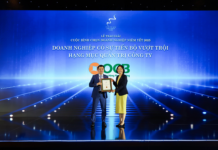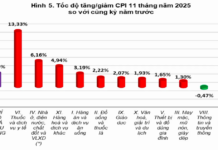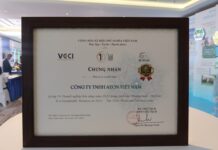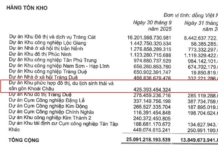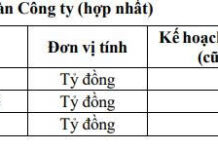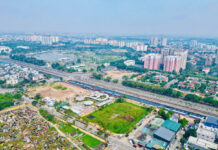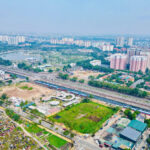On August 30th, the Management Board of the Project for Construction of Traffic Works (Traffic Project Management Board – investor) organized a ceremony to inaugurate the Binh Hung Wastewater Treatment Plant (in Binh Chanh district, Ho Chi Minh City).
Mr. Bui Xuan Cuong, Vice Chairman of the Ho Chi Minh City People’s Committee, affirmed that the city always considers environmental protection, increasing green space, treating waste and wastewater, improving canals and improving the lives of people living on and along the canals as the key task of the entire political system.

Vice Chairman of Ho Chi Minh City People’s Committee Bui Xuan Cuong speaks at the inauguration ceremony. (Photo: Luong Y)
“The two key tasks that Ho Chi Minh City strives to implement by 2030 are to collect and treat 100% of domestic wastewater in 12 drainage basins with a total volume of about 3 million cubic meters/day and to collect and treat by incineration technology, recycling 100% of the city’s waste volume. up to now, with the operation of Binh Hung Wastewater Treatment Plant, the city’s wastewater collection and treatment rate will increase from 20.6% to 40.8%, and is expected to reach 71.3% in 2025 after the Nhieu Loc – Thi Nghe Treatment Plant with a larger capacity of 480,000 cubic meters/day comes into operation in 2025,” Mr. Cuong added.
The Vice Chairman of Ho Chi Minh City People’s Committee also said that Binh Hung Wastewater Treatment Plant not only has the function of treating wastewater but has also been planned and built into a green destination with dozens of hectares of green space, laboratories, and monitoring systems to become a place for learning, training, and environmental education for Ho Chi Minh City people, especially young citizens.
Binh Hung Wastewater Treatment Plant, along with the drainage system and pumping stations, has also become a training ground for human resources in the field of drainage and wastewater treatment in Ho Chi Minh City with a team of engineers and workers ready to take on the task of managing and operating the city’s wastewater collection and treatment systems in the future.
Mr. Luong Minh Phuc, Director of Ho Chi Minh City Traffic Project Management Board, said that after nearly 20 years of implementation, from a muddy and marshy island, it has become a modern wastewater treatment plant, with a treatment capacity of 469,000 cubic meters/day (the largest in the country up to now).
To implement the project, Ho Chi Minh City has set aside a separate island with a total area of 42 hectares for the construction of Binh Hung Wastewater Treatment Plant Phase 1 and Phase 2.

Leaders of Ho Chi Minh City and representatives of related units at the inauguration of Binh Hung Wastewater Treatment Plant.
Binh Hung Wastewater Treatment Plant is part of Package J – one of the six large packages of the Ho Chi Minh City Environmental Sanitation Project Phase 2, serving the Tau Hu – Ben Nghe – Doi – Te canal basin, with a total investment of nearly VND 11,300 billion, funded by ODA loan capital from Japan and domestic counterpart funds. This package is implemented to collect and treat domestic wastewater for an area of more than 2,100 hectares, including Districts 4, 5, 6, 8, 10, and 11, meeting the wastewater treatment needs of about 2 million people.
The wastewater collection system will start from the entire basin, then the wastewater will be transferred to the drainage system under Package G, then transferred to the Dong Diep pumping station in District 8. Here, the wastewater will go through a preliminary process of removing sand and garbage before being pumped through a 2.8km long pipeline to the Binh Hung Wastewater Treatment Plant for treatment.

Binh Hung Wastewater Treatment Plant has the largest capacity in the country at the moment. (Photo: Luong Y)
With the continuous operation of the wastewater collection and treatment system, the level of water pollution in the Tau Hu – Ben Nghe – Doi – Te canals is expected to decrease significantly, limiting the phenomenon of black canal water. In the upcoming Phase 3, Ho Chi Minh City will continue to increase the treatment capacity to 512,000 cubic meters/day, helping to treat a large amount of wastewater from the Te canal area along District 7.
Proposed Planning for Adding 2 New Cities in Ho Chi Minh City
According to Architect Ngô Viết Nam Sơn, Ho Chi Minh City should consider planning two cities within the city in the south and north.
Three Economic Growth Scenarios for Ho Chi Minh City in Q1 2024
At the socio-economic meeting reviewing the results of January and setting the goals for February 2024, held this morning (1/2), the Ho Chi Minh City Institute for Research and Development has presented three economic growth scenarios for the first quarter of Ho Chi Minh City.






